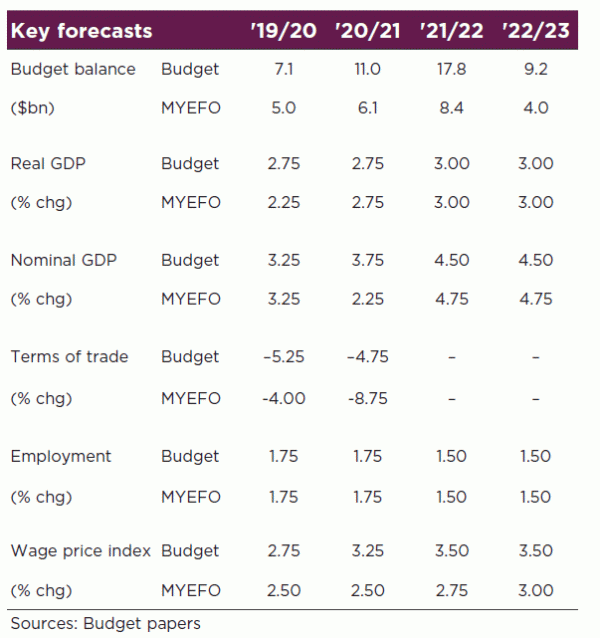Federal budget update and the policy debate
The Federal government has sharply downgraded the fiscal outlook in its Mid-Year Economic and Fiscal Outlook (MYEFO), released today.
In particular the forecast budget surpluses for 2020/21 and 2021/22 have been reduced from $11.0bn and $17.8bn to $6.1bn and $8.4bn respectively.
Below we discuss the details behind these revisions but the key is the reduced expectation for growth in nominal GDP in 2020/2021 from 3.75% in the Pre-Election Fiscal Outlook (released shortly after the May 2019 Budget) to 2.25%.
In our Preview we estimated that nominal GDP growth for 2020/21 would be revised down to 3.0%, which included a downward revision to wages growth in 2020/21 from 3.25% to 2.75%. The government has gone further and cut the wages forecast to 2.5% – no lift in wages growth from the 2019/20 forecast of 2.5% and in line with the Reserve Bank’s thinking.
We estimate that the difference between our own forecast that nominal GDP growth in 2020/21 would be lowered to 3.0% in this document and the government’s forecast of 2.25% is explained about 50/50 between a weaker wages/ prices forecast and a lower profile for commodity prices – largely centred around coal.
There are upside risks to the commodity price forecasts but we can understand why the government would be cautious around these forecasts in MYEFO – wanting to avoid a further fiscal downgrade when the 2020 Budget is announced on May 12. Readers will be aware that Westpac has argued that the economy needs some fiscal support to complement monetary policy as the cash rate nears the effective lower bound of 0.25%. The MYEFO includes net new spending of $8.1bn over four years – more than we had anticipated but insufficient to make much of a difference.
We have recommended bringing forward the legislated personal tax cuts in two tranches of $7bn per year in both 2020/21 and 2021/22. Under the PEFO fiscal estimates of surpluses of $11.0bn and $17.8bn the government could have achieved that objective while still maintaining modest surpluses of $4.0bn and $3.8bn respectively.
Under these new fiscal estimates from MYEFO the fiscal position would change to deficits of $0.9bn and $5.6bn, respectively if the tax cuts were to be brought forward.
However it is reasonable to argue that the downbeat forecasts in MYEFO only emphasise the need to provide some additional policy stimulus for the economy.
We accept that given the government’s current approach of favouring the return to surplus over the need to provide a strategic boost to the economy the chances of a decision to use the May 2020 Budget to help reboot the economy are low if such a policy would require a move back into deficit
Given the disappointing outlook for the economy, as set out in MYEFO, it is reasonable to expect that as we move towards the May Budget the government will recognise the need to use fiscal policy to boost demand at the possible expense of sustained budget surpluses.
Overview
The economic outlook is softer than anticipated in the May Budget – which translates into lower tax revenues and a lower profile for the budget surplus. See table attached for details. The key revision is the downgrade to nominal GDP growth for 2020/21, lowered to 2.25% from 3.75% at Budget time (we had anticipated a figure of 3.00%).
The smaller than anticipated economy costs the budget surplus $13.5bn over the four years. Net new spending is more extensive than anticipated, at $8.1bn over the four years.
The revised budget surplus profile for the four years from 2019/20 is: $5.0bn (from $7.1bn); $6.1bn (from $11.0bn); $8.4bn (from $17.8bn); and $4.0bn (from $9.2bn). The downgrade over the four years is $21.5bn.
Economic outlook/forecasts
The profile for real GDP growth – output – is as we anticipated in our Preview.
For 2019/20, growth has been downgraded by 0.5% to 2.25%, incorporating the weaker starting point as evident in the September quarter national accounts
Thereafter, the real GDP growth forecasts are unchanged from May (2.75%, 3.00% and 3.00%). This is on the optimistic expectation that monetary and fiscal policy stimulus will soon begin to impact and on the standard assumption that over the projection period the output gap will gradually begin to close.
The size of the economy (nominal GDP) in 2019/20 is unchanged from Budget, at growth of 3.25%. This is as anticipated. In short, the weaker real economy is being offset by commodity prices staying higher for longer.
In 2020/21, as commodity prices correct lower, nominal GDP growth is squeezed – albeit by more than we anticipated. Growth is cut to 2.25% from 3.75%, a downgrade of 1.5ppts. The terms of trade declines by a sharp 8.75% in the year.
Thereafter, nominal GDP growth is not greatly different from Budget time, at 4.75% and 4.75% (rather than 4.5% and 4.5%).
On commodity prices, MYEFO adopts a cautious approach. The May 2020 Budget provides an opportunity to reassess.
For iron ore, the Budget forecast of US$55/t has been retained – albeit with a delayed timing, pushed back to June 2020 from March 2020. This is as anticipated and this forward profile is broadly in line with our central case view (we expect the price to reach around these levels during the second half of 2020). Currently, the iron ore price is around US$90 to 95/t spot – with the expectation of a correction in 2020 as supply from Brazil comes back on stream and on weaker demand from China.
The coking coal price has been downgraded (rather than being retained, as we assumed) – lowered to US$134/t from US$150/t.
On wages, MYEFO forecasts wages growth holding at 2.5% this year and next, and then in the projection period, lifting gradually to 2.75% and then 3.00%.
In the attached table, we set out the key economic forecasts published in MYEFO. Risks to the upside, near-term, are that commodity prices stay higher for longer. Risks to the downside are around the real economy – which continues to be buffeted by powerful headwinds, notably: the sharp home building downturn; weak wages growth; high household debt levels; and an uncertain global backdrop. The projections – for the years 2021/22 and 2022/23 – are on the optimistic side, factoring in back-to-back years of above trend growth
Budget surplus revisions
The budget surplus profile has been downgraded to reflect the weaker economy and modest new spending. The revised budget surplus profile for the four years from 2019/20 is: $5.0bn (from $7.1bn); $6.1bn (from $11.0bn); $8.4bn (from $17.8bn); and $4.0bn (from $9.2bn).
Over the four years, the surplus has been downgraded by $21.5bn. New policy measures cost $8.1bn over the period, while the weaker economy costs the budget $13.5bn (receipts are down by about $33bn, partially offset by around $19.5bn in lower payments).
Policy decisions cost $2.2bn in 2019/20, $3.0bn in 2020/21, $2.0bn in 2021/22 and $1.0bn in 2022/23. The focus is on Aged Care, the drought, and infrastructure.
Parameter variations (the impact of the weaker economy) cost the budget $13.5bn, with no impact in 2019/20, -$2.0bn in 2020/21; -$7.5bn in 2021/22; and -$4.1bn in 2022/23. Receipts are down by $33bn, of which $9.9bn is associated with lower GST collections. As this is a state tax, there is a corresponding $9.9bn reduction in Federal payments to the states.
Individuals taxes are down by $7.4bn over the four years, despite a $2.1bn upgrade in 2019/20 (associated with higher capital gains and dividend income). Downgrades over the four years also relate to: company tax collections, $7.9bn; superannuation fund taxes, $1.6bn; ‘other’ indirect taxes, $2.1bn; and non-taxation receipts, $2.1bn.
Turning to the $19.5bn in lower payments, the largest reduction is the $9.9bn downgrade to GST provisions for the states. The lower interest rate environment results in a $3.9bn reduction in debt servicing costs. Payments across a number of programs are lower over the four years, including: Defence Housing Australia ($1.3bn); Family Tax Benefit ($1.2b); and Student Payments ($0.7bn).
















